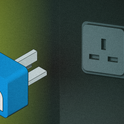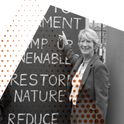
Songdo in South Korea: "this type of city is no longer a static collection of places but 'a computer in open air'" © Gwoan Joong Kim/Topic Photo Agency/Corbis
The “Exhibition of the Industry of All Nations” opened in May 1853 on Reservoir Square, New York and caused a tourist boom, similar to the one caused by the Great Exhibition in London two years earlier. Each day in one of the main halls a crowd gathered, huddling in front of a stage upon which stood a structure that appeared at first glance like a gallows. Above a platform rose a tall structure of wooden boards with ropes hanging off to both sides. As workmen took the strain, pulling the ropes taut, the platform rose bearing the inventor Elisha Otis as well as barrels and heavy boxes, until it reached 30 feet above the heads of the throng.
After a dramatic pause an assistant cut the hoists with an axe and the crowds gasped as they expected to see the engineer crash to the ground. But the platform only dropped a few inches and remained there, suspended in the air, held by Otis’s patented safety device, the “safety hoister.” Above the murmur of astonishment, Otis assured his stunned audience, “all safe, gentlemen, all safe.” It was a spectacle that changed the history of the world. Otis had not invented the elevator, but had made it safe. Before Otis’s innovation, few places in the world—apart from Sana’a, in Yemen—had buildings over five storeys high; within 50 years there were skyscrapers overlooking Manhattan.
Cities and technology have long influenced each other. Otis’s elevator was invented at the same time as innovations in railways, sewers and steel manufacture; combined they would determine the shape and scale of the modern city. Today, we are experiencing a new technological leap: the intelligent city, which is being heralded with the same fevered, messianic optimism and hard sell as Stephenson’s Rocket or Bazalgette’s sewers. To be smart is to be modern, we are told; a failure to embrace the liberating power of information is to be morally suspect. But this poses the question of what precisely the role of technology might be in the modern city. Can it turn a leaden metropolis into a sustainable, robust utopia?
For some urban thinkers, the solution to all our current problems is to start again, from scratch. Songdo, in South Korea, is an example of the next generation of metropolis: a smart city, built according to the new rules of the Information Age. Built from reclaimed land 40 miles southwest of Seoul, it is a connected city, in which information is gathered and used to regulate the urban fabric. Buildings, objects, traffic lights are both sensors and activators. This type of city is no longer a static collection of places but “a computer in open air.” It is a sentient place—a living and connected matrix in which buildings, signs, users and vehicles communicate with each other in real time.
Songdo’s promotional brochure notes that the city appropriates the canals of Venice, Hong Kong’s skyline, the park areas from Savanna Georgia and Napoleon’s sense of street planning, and mixes it all up together. Beneath this architectural melee the city is wired with Cisco’s proprietory U.City infrastructural software, meaning that Songdo can be run from a hub that functions as the city’s “brain stem,” gathering data from the sensors scattered throughout the city.
Street cameras watch the human flow to brighten the energy-saving street lamps that shut down when no one is around. Sensors surveil street traffic, collecting registration plate data to monitor congestion. Buildings, bridges and infrastructure are connected to avoid unexpected works or delays. On top of buildings, mini stations predict the weather, sending warnings when temperatures drop to a level that might cause a surge in energy use for heating. All waste, rubbish, energy use and water is metered and measured, offering potential ways to reduce inefficiencies.
Is this an efficiency dream? Or a control nightmare? It’s hard to decide. The modernist era saw planned cities such as Brasília, Canberra and Chandrigarh, built from the dirt, as well as the more local post-war new town plans of Peterlee, Welwyn Garden City and Washington. Each was created as an expression of hope for the future—so what do smart cities tell us about ourselves?
In addition to Songdo, new cities are appearing everywhere. Masdar City has been created outside Abu Dhabi by Norman Foster as the first carbon-free city. In China there are numerous plans for eco-cities that harness information technology to make more sustainable environments. Often the techno-utopian claims made for such cities need to taken with a pinch of salt. Most of us will never live in cities created out of the desert. The prospective populations of these cities are minute compared to the majority of the global population that already lives within the dense, complex, and often straining-at-the-limits cities built from bricks, stones, steel and lives of the pre-Information Age. These cities face the challenge of adapting as best as possible to advances in technology even though they are poorly positioned to do so.
In November 2010, David Cameron announced the launch of Tech City, an initiative that hoped to turn a stretch of east London—from Shoreditch to Stratford—into the technology capital of Europe. The dilapidated post-industrial East End was to be transformed into a new gleaming smart hub: Silicon Roundabout, named after the Old Street roundabout. So did it work?
Within a year of Cameron’s announcement, Tech City had attracted huge attention from international companies. The high profile push has raised the international standing of the project. For big tech companies looking for a place to site their European office, the publicity drive has worked. However, local start-ups have lost out, and with them has gone an important source of innovation. According to Elizabeth Varley, founder of TechHub, a hugely successful community workspace close by Old Street roundabout, the top-down initiative needs to be questioned. Around the roundabout itself there has been little investment: the tube station, one of the least attractive in the city, has not been improved. There has not even been an upgrade to the neighbourhood’s broadband capacity. There are fears that the main effect of government cheerleading will be to raise rents.
According to Varley, the most urgent matter was the lack of government investment—but in the people rather than the place, with small grants “so that a young entrepreneur can eat for six months.” A 2012 report by the Centre for London put the case for development from the ground-up rather than a policy to attract outside investment. The report concluded: “It has been evolving for years under the policy radar, and only now—as it reaches critical mass, and becomes the figurehead of London’s digital economy—is it receiving much public attention... Tech City should be about taking what inner East London already has and helping it get even better.”
Other British cities are adapting to new technology. In November 2012 Birmingham announced its Smart City Vision, which confronted precisely this challenge. Despite having the youngest population in the UK, 18.5 per cent of Birmingham’s adult population still has no access to the internet. Overcoming this is the first step. Second, local government should become more efficient and find new ways to deliver services and share more between departments. There will also be a commitment to smart energy use, intelligent architecture and infrastructure planning—out with the old Victorian systems, in with the new.
The promise made by Birmingham’s Smart City Vision was that: “Technology will be seamlessly interwoven into the fabric of our city life to provide better information, more choice, more convenience and less waste for our citizens, businesses, communities and public services.”
The optimism and sense of ambition is laudable, as was the Victorian mission to provide clean water, sewers, and fresh air. But these plans are expensive. The installation of meters to measure energy and water usage has a price; there is no guarantee that “ultra fast digital connectivity” will attract “inward investment, create jobs and drive innovation.” This “joined up, integrated and citizen-centric approach across city systems and processes, using and sharing real time data and intelligence” might lead to better decision making. But this is dependent on the quality of the people making the decisions, not just the size of the data set.
Amsterdam Smart City, launched in 2009. Like Birmingham, it is looking to upgrade its infrastructure. One lesson concerned the willingness of residents to take in the technological developments that were occurring around them. The lesson of Amsterdam is that citizens’ tolerance for high-tech lectures from city officials is low.
Big schemes like this have to come from city hall, but they must be promoted with caution; both Birmingham and Amsterdam propose widespread top-down schemes that risk promising too much.
In addition, the intelligent city must not become a cage. The amount of security technology installed in London in advance of the 2012 Olympic was astounding. In Rio de Janeiro, in preparation for the 2014 World Cup, the city has worked with IBM to create an all-seeing information hub that collects data and could be the nerve centre during an emergency. It can also be used to watch and monitor the city from every angle.
Most of the major software companies have developed the proprietary code to make and market the future metropolis. Big players such as IBM, Cisco, Siemens, Phillips, and GE are entering the debate on the intelligent city. These big companies are talking to city halls, offering end-to-end solutions, the complete package to retrofit the everyday city for the 21st century.
Some of the most interesting ideas are coming from the MIT SENSEable Lab, run by the architect and designer Carlo Ratti. Ratti’s team at MIT has looked at a number of projects that help the gathering together of huge sources of information that allow us to understand the city—not how we think it might work but how it actually, empirically functions. One project used small GPS monitors to find out where our trash ended up. Starting in Seattle, the team discovered that parts of the city’s trash travelled thousands of miles, some items even crossing borders before being discarded.
Elsewhere, the Copenhagen Wheel, an attractively designed add-on to the back wheel of an ordinary bike, works both as a miniature engine that stores energy for those moments when you need a little help, and a multi-sensor that gathers data on your performance, traffic and air pollution. Simple devices like this could have as large an impact as the massive city-wide public infrastructure projects.
However, in the hope of developing the intelligent city, perhaps the most radical gesture is also the cheapest. City governments have been gathering data for decades; the use of information technology will make this easier, faster and bigger. But who owns this information? In 2009 Mayor Michael Bloomberg opened the New York City Open Data archive that made copious amounts of city data public. In 2010 Mayor Boris Johnson did the same in London; and since then has been followed by numerous cities around the world.
The datastore is not just a mechanism for transparency. While it is important that the city government proves itself to be open and accountable, establishing a sense of trust between the city and city hall, the variety of information being offered to general scrutiny has a far more valuable potential in engaging the active citizen. Once data is made available, city hall loses control on how that information is used, and by whom: hackers, activists, website designers, coders or app entrepreneurs. It can be utilised to start a political campaign or launch a new business.
This donation of the control of information by the traditional government powers to whoever has a broadband connection and a special interest is perhaps the start of the real intelligent city.











